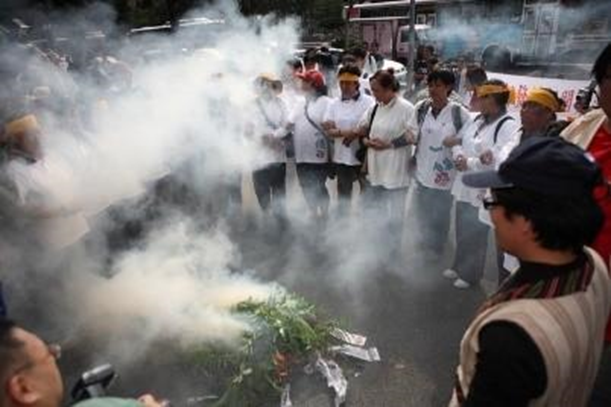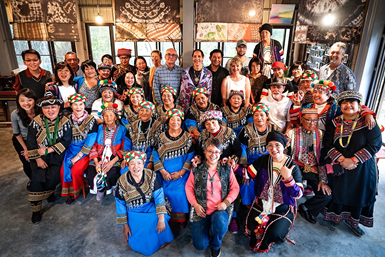那瑪夏守護狼煙的女人:原住民族女性的主權故事
那瑪夏守護狼煙的女人:原住民族女性的主權故事
這個研究描繪莫拉克颱風災後,那瑪夏一個原住民族婦女組織災後守護部落主權的故事、她們主動服務族人並對抗國家政策、最終成功返鄉重建。她們的行動充滿力量。這段動人的故事是本文作者林津如教授與那瑪夏原住民族婦女共同經歷而寫成的血淚史,以災難治理、原住民族主權、原住民族女性主義等角度切入,以期對學術有所貢獻。
女窩:那瑪夏的原住民族婦女組織
「女窩」是高雄市那瑪夏區的原住民族婦女組織,由卡那卡那富族的阿布娪.卡那斐依亞那(Apu’u Kaaviana)在2003年推動成立。這個原鄉婦女組織持續在部落推動原住民族的文化復振、以文化照顧部落兒童、培力婦女成為具文化自信的人。
國家的永久屋政策 想要把族人遷離原鄉
2009年莫拉克颱風災害重創南台灣,政府與慈善團體合作在平地興建永久屋,立法通過《莫拉克颱風災後重建條例》強制部落族群遷離原鄉。對於都市人來說,災後被贈與一間房子,看似非常優惠。對於長居部落的族人來說,雖獲得一間平地的屋子,卻得放棄部落房宅與土地,遠離了土地、文化與根源。國家政策僅提供單選題,山上或山下,去或留,二擇一的難題撕裂了原住民族人。
國家決定將災民臨時安置於營區 造成災民生活的痛苦
國家為了維持政策方向,堅持不搭建中繼屋,僅把災民安置在閒置營區。那瑪夏的族人被臨時安置於距離家鄉86公里之遙的仁美營區。族人不知道何時才能返鄉,且營區空間非常陽剛、沒有隱私性、非常不適合當作臨時安置的場合,族人在那裡感覺非常痛苦。
災難後女性選上自治會長,女窩組織起來服務族人
災難救援的各方利害相關人(縣政府、軍方、社會團體等)一開始各自行事,並不聆聽原住民族災民的需求與聲音。族人被安置到仁美營區之後,女窩立刻組織起來用自己文化的方式照顧孩子與耆老。她們雖然用盡心力來照顧族人,卻被排除在災難治理的決策之外。最後,族人自主發起投票改選,女窩領導人阿布娪.卡那斐依亞那被選為仁美營區的災民自治會會長,女窩開始和外部單位在安置營區進行共治共管。
從原住民族人的需求出發,在災後混亂的狀況下,女窩陪伴部落最辛苦的家庭。在營區安置期間,她們仍建立與祖靈的連結、在營區吟唱傳統歌謠,邀請巫師與牧師舉行各種傳統與現代儀式來療癒族人。她們也在去人性化的陽剛軍營中,努力打造出性別友善的空間,維護婦女人身安全。
「女窩」上街抗議國家政策 終於得以返鄉
為了能夠回到原鄉重建,延續部落文化,女窩和其他來自不同部落的原住民族人,一起站上抗爭第一線,她們在行政院前面、也在高雄縣政府前面、點起狼煙、強烈表達她們返鄉的訴求。最終,她們抗議成功,高雄縣政府決定放棄臨時安置,在原鄉仍沒有水沒有電的狀況下,讓族人返回原鄉重建。
應用:長期陪伴並熟悉部落文化 為高醫那瑪夏USR計劃奠基
林津如教授長期陪伴那瑪夏婦女走過災後重建,2013年部落婦女在那瑪夏蓋起了窯,用在地植物做成窯烤麵包,開創「深山裡的麵包店」,帶動那瑪夏地區的觀光產業與經濟。林津如教授也開始帶領性別所學生進部落學習。
高醫大從2017年開始規劃那瑪夏USR計劃,林津如教授主張以生態教育為計劃亮點,設計「那瑪夏學」邀請那瑪夏族人成為高醫學生的老師,強調高醫大應積極向原住民族人學習、尊重並發揚原住民族的生態觀與世界觀。此計劃的核心價值為高醫大那瑪夏USR計劃奠定良好的基礎,獲得外界高度肯定。
圖形摘要

2009年 林津如老師與女窩在行政院前守護狼煙,捍衛原住民族主權

2019年林津如老師主持高醫大那瑪夏USR計劃主軸一,與深山裡的麵包店合作策展,邀請自美國和澳洲的七位原住民學者,一同參與部落的「莫拉克風災十週年展」。 會後大合照。
【研究團隊】
團隊成員:林津如 教授
代表單位:高雄醫學大學性別研究所
團隊簡介:林津如教授研究團隊長期關注原住民族之性別議題,強調參與過程中應與部落合作伙伴建立尊重、平等、互惠的長期合作關係。
研究聯繫Email:cjlin@kmu.edu.tw
【論文資訊】
論文出處:林津如(2023)〈守護狼煙的女人:莫拉克颱風災後原住民族女性的主權實踐〉《人文及社會科學集刊》35(2):391-433。
全文下載:https://www.rchss.sinica.edu.tw/jssp/journals/3208
The Women Who Guarded the Ancestral Fire: Sovereign Practices of Indigenous Women in Namaxia
The Women Who Guarded the Ancestral Fire: Sovereign Practices of Indigenous Women in Namaxia
This study tells the story of an Indigenous women's organization in Namaxia that defended Indigenous Sovereignty in the aftermath of Typhoon Morakot. Challenging the government's resettlement policy, they took initiatives to serve their people, fought against state policies, and eventually returned home after the disaster. Prof Lin documents these powerful stories and contributes to the knowledge of disaster management, Indigenous sovereignty and Indigenous Feminism.
Women's Nest: An Indigenous Women's Organization in Namaxia
Women's Nest is an Indigenous women's organization in Namasia District, Kaohsiung City. It was founded in 2003 by Apu'u Kaaviana, who is a member of the Kanakanavu nation. This Indigenous women's organization engage in cultural revitalization, caring for children collectively, and empower women to become culturally confident.
The Forced Relocation Policy After Disaster
When Typhoon Morakot devastated southern Taiwan in 2009, the government passed the Typhoon Morakot Reconstruction Ordinance to force tribal communities to move out of their homelands. For city dwellers, a free house after a disaster may seem like a big favor. However, the gift of a house far away from home also means giving up their lands and homes, culture and roots in the mountains. National policy offers only one choice, to stay or to go. The dilemma of choosing between uphill or downhill is tearing Indigenous peoples apart.
Meanwhile, residences of Namaxia were temporarily relocated to Renmei camp, 86 kilometers from their homeland. They did not know when they would be able to return to their home land, and the camp was very masculine, with no privacy, unsuitable for temporary relocation, providing poor post-disaster conditions.
Indigenous Women Made the Lead After Disaster
Those involved in the relief work (such as district officials, the military, social services, etc.) initially acted in isolation and did not listen to the needs and voices of the Indigenous Peoples. Once relocated to the camp, the Women's Nest immediately organized themselves to care of their children and elders collectively. Nevertheless, they were excluded from disaster management decisions. Eventually, the community members initiated democratic elections. Apu'u Kaaviana was elected as the representative and the Women's Nest began co-governing with multiple stack holders in the temporary camp..
The Women's Nest supported the families of the community in the chaotic situation after the disaster. Throughout the resettlement period, they have continued to connect with their ancestral spirits, singing traditional songs in the camp and inviting shamans and priests to perform a variety of traditional and modern rituals to heal their people. They were also working to create gender-friendly spaces and ensure the safety of girls in the dehumanized, masculine camp.
Protesting Against State Policies Successfully
The Woman's Nest and other Indigenous communities stood at the forefront of protests in front of the Executive Yuan and the Kaohsiung County Government, lighting up smoking fires strongly expressing their demand to return to their homeland. In the end, their protest was successful and the Kaohsiung County Government decided to give up the temporary relocation and allow Indigenous communities to return to their home land, with no water, no road, and no public services available.
Application and Highlights: Indigenous Knowledge lay the foundation for KMU Namaxia USR
Professor Lin has accompanied the women of Namaxia throughout the post-disaster for 14 years. In 2013, Indigenous women in Namaxia built a kiln and used local plants to make kiln-baked bread, creating ‘The Bakery in the Mountains', which has boosted the tourism industry and economy of the Namaxia region. Professor Lin has also begun to bring students from gender studies to learn in Namaxia since 2011.
Since 2017, Kaohsiung Medical University has begun preparing the Namasha USR (University Social Responsibility) project. In the team, Professor Lin has advocated vigorously Indigenous ecological knowledge as the highlight of the project. She also designed the course "Namaxia Studies" to invite Indigenous people become teachers for the KMU students. She emphasizes that the university should actively learn from the Indigenous Peoples, respecting and promoting the ecological and world views of the Indigenous Peoples. This core value has laid a good foundation for the KMU Namaxia USR project, which has been a great success in these years.
Graphical Abstrac

Women’s Nest and Professor Lin Protesting in front of the Executive Yuan, defending the sovereignty of the Indigenous peoples in 2009.

In 2019, Professor Lin curated an exhibition in collaboration with the Bakery in the Mountains. We Invited seven Indigenous scholars from the USA and Australia to participate in the Morakot 10th Anniversary Exhibition.
Research Team Members: Professor Chin-ju Lin
Representative Department:Graduate Institute of Gender Studies
Introduction of Research Team:
Professor Chin-ju Lin's research team has a long-standing interest in Indigenous gender issues and emphasizes the importance of building respectful, equal and mutually beneficial long-term relationships with Indigenous partners in the participatory process.
Contact Email: cjlin@kmu.edu.tw
Publication:
Lin, Chin-ju (2023) The Women Who Guarded the Ancestral Fires: Sovereignty Practices of Indigenous Women after Typhoon Morakot, Journal of Humanities and Social Sciences 35(2): 391-433. Doi: 10.53106/1018189X2023063502005
Full-Text Article:
https://www.rchss.sinica.edu.tw/jssp/journals/3208


